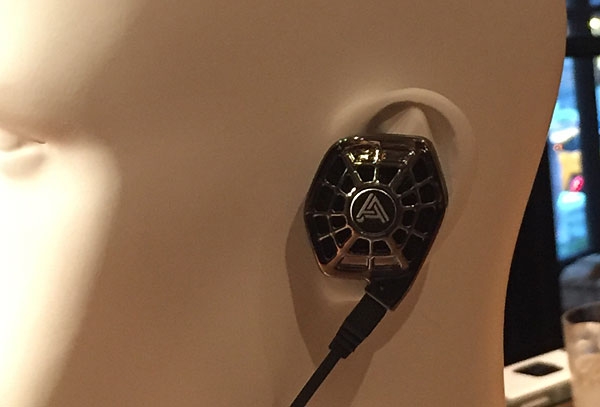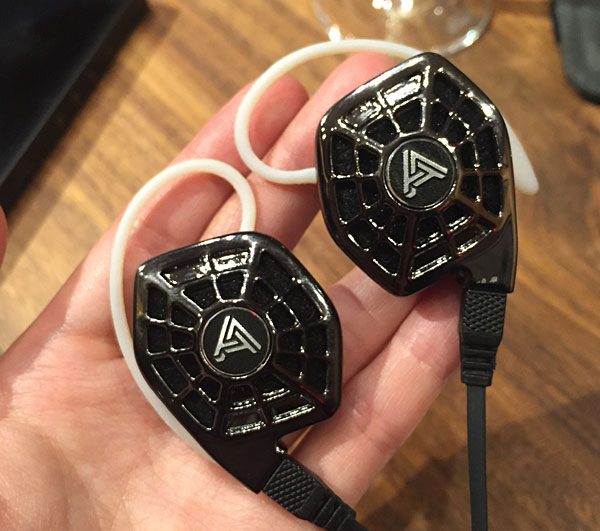| Columns Retired Columns & Blogs |
They look like spiderman started making dreamcatchers.

The event was held at Manhattan's 1 Hotel Central Park, a chic combo of nature and urban architecture. Dark wood, warm lights, floor-to-ceiling glass panels overlooking the city. A DJ played upbeat electronic music at just the right volume. Trays of mini crab cakes, risotto balls, and steak tartar circulated while chit-chatting press folk routinely raided the complimentary beverage table.
On the far side of the space was a closed off glass listening room equipped with a handful of iSines to listen from either preloaded hi-rez players, iPads, or your own smart device. (The headphone cable includes the 24-bit DAC, so the iSine can be driven directly from an iDevice's Lightning jack—prospective iPhone 7 purchasers take note.) A woman sporting a high-cut dress assisted in providing and replacing ear tips. Audiophile circles enthusiastically discussed the unthinkable feat of creating in-ear planar magnetic headphones in a growing line outside the room (footnote 1).

I listened to the iSine10's for maybe 10 minutes before I felt guilty holding up the flow of the forming line. It was enough time to know that I enjoyed them, but not enough to write a confident detailed review. In short, upon first impression, I found the iSine10s to be fairly warm and airy. They were also much lighter in weight than I had expected.
Most events in the high-end audio industry contain the following elements: (hopefully) good sound, (sometimes) good food, and (always) free alcohol. This event satisfied my expectations in all three. But there's one more element I can usually count on at these types of events - I often find myself being told what to hear, being told that I won't be told what to hear, being asked what I heard, being corrected about what I've heard, and so on.
What I enjoyed most about the Audeze Sensory Experience was that none of that attitude was present. I briefly conversed with Audeze's Founder/CEO Sankar Thiagasamudram, but not once did he attempt to force-feed me marketing information or approach me with the usual awkward audiophile-y reverse psychology.
It was purely about the sensory experience, aptly titled. It was as if I had stepped into a modern day less extravagant, audiophile centered Gatsby-esque party.
This got me thinking—is this part of the solution to converting more music-loving non-audiophiles into avid, fierce appreciators of sound? Invite them to events like this one? This thought had never crossed my mind at previous launch events or listening gatherings, but now it all seems so clear. Perhaps the answer is in building upon the overall sensory experience as a whole. Perhaps we need to eradicate the whole "this is what you're hearing" mentality, and create an experience that shows (but doesn't tell) how fun and cool experiencing good sound can be.

They look like spiderman started making dreamcatchers.

I will be interested in longer term comfort reports. I have never been able to abide by those "ear bridge" holder devices.

In my opinion, the most serious problem of the audio industry is not its lack of hospitality, but its lack of credibility. Young people see some audiophile products and their prices as fraudulent. They see the reviewers touting such products as deceitful. Because consumers shy away from industries they don't trust, the consequences are disastrous for everyone in the business.

All Audeze products to date have been made in America, so I'd expect these are as well. Considering that, so far, all Audeze headphones are at or near the top of their class, even competing against headphones that are made in China but sell for just as much if not more, the price seems justified. Whether or not an individual feels any pair of in-ear headphones are worth $400 is up to that person, of course, but I've owned two pair of Audeze and found both to be spectacular.

Almost 400 U.S. $ for the 10, probably made in PRC
I asked where the iSine10s were made and while some of the parts are sourced from overseas, the unique drive-unit is made at Audeze's California plant, which is also, I understand, where final assembly also take place.
And as for pricey, in the November issue I review Shure's new electrostatic IEMs, which retail with the energizer/DAC for $2995.
John Atkinson
Editor, Stereophile

The best answer is to head to a retailer, audio show, or headfi meet-up and take a listen to open backed phones. If you can listen as you'd like while people around you are chatting, you have your answer.

Well, we're not certsin about the place of manufacture : for example in Europe or Japan, some products are just assembled, the parts come from who know where (ahem).
In Italy you could just write 'made in ..." and the finished piece is from eastern asia...
For the price, we can't tell, how much is factory's income, for me I don't like to spend so much on earphones but that's up to you. I owned an Ergo after my Jecklin Float costing approx 100 U.S. $ and that's already too much for some persons.

Not a "can" fan nor ear buds. I look forward to your next piece- Jana.

Thanks for the range of posts you have shared, I look forward to reading more from you!

There are IEMs that sold for $4000 or so years ago, the Final Audio copper series for example. My experience with high-end speakers tells me that most of those converge on a representative high fidelity sound, probably because they're tuned for a room. IEMs, and even headphones to some extent, are much more variable, probably because the users' heads are so different. The Focal Utopia as reviewed by Innerfidelity is a good example. Most serious reviewers are reporting it as "best headphone sound ever", yet it's generally admitted that the lower bass is just a bit shy.